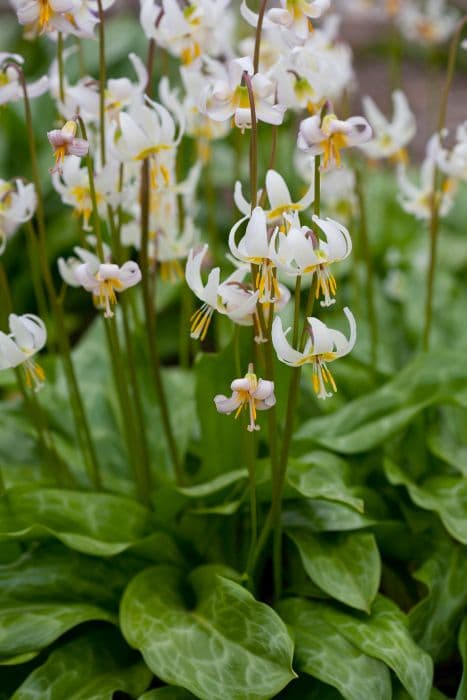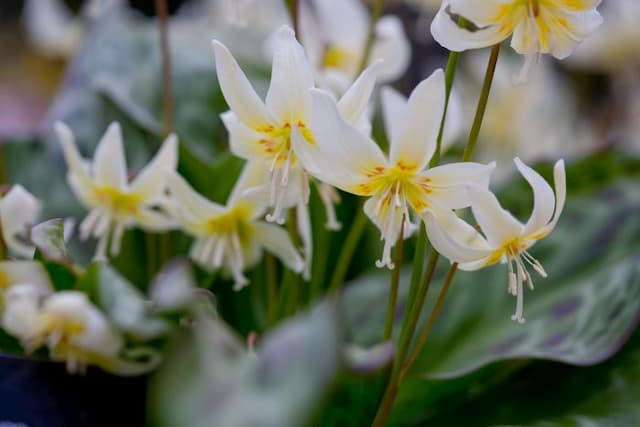David's Fritillary Fritillaria davidii

ABOUT
Fritillaria davidii, commonly known as David's fritillary, is an eye-catching flowering plant. It is recognized by its bell-shaped flowers, which typically exhibit a distinctive purple or greenish-purple hue, sometimes adorned with checkered patterns on the petals. The flowers, gracefully nodding, are arranged on a single, upright stem, presenting an elegant droop. The leaves of David's fritillary are lanceolate, meaning they are shaped like a lance, with a pointed tip and a wider base, presenting a sleek and slender appearance. The foliage is characteristically glossy, which adds to the visual interest of the plant. Wrapped around the stem, the leaves are sometimes arranged in a whorled or spiraling pattern, which creates an attractive texture and a sense of movement in the plant's structure. The overall presentation of David's fritillary is delicate yet bold, with its vibrant colors and unique flower patterns capturing attention in any garden or natural setting where it blooms.
About this plant
 Names
NamesFamily
Liliaceae
Synonyms
David's Fritillary
Common names
Fritillaria davidii.
 Toxicity
ToxicityTo humans
The toxicity of Fritillaria davidii, also known as David's fritillary, to humans has not been clearly established in the scientific literature available up to my knowledge cutoff date. It is generally advised to handle plants with caution and avoid ingesting any part of unknown plants due to potential risks. If you suspect poisoning from any plant, including David's fritillary, it is important to seek medical attention immediately.
To pets
The toxicity of Fritillaria davidii, commonly referred to as David's fritillary, to pets such as dogs and cats is not specifically documented. However, many plants in the Fritillaria genus contain alkaloids that could potentially be toxic to pets if ingested. Symptoms of poisoning may include vomiting, diarrhea, abdominal pain, drooling, and lethargy. In case of ingestion, contact your veterinarian promptly for guidance and treatment.
 Characteristics
CharacteristicsLife cycle
Perennials
Foliage type
Deciduous
Color of leaves
Green
Flower color
Purple
Height
1 foot (30 cm)
Spread
1 foot (30 cm)
Plant type
Bulb
Hardiness zones
6
Native area
China
Benefits
 General Benefits
General Benefits- Aesthetic Value: Fritillaria davidii, commonly known as David's fritillary, has striking bell-shaped purple flowers that contribute to garden aesthetics and appeal to gardeners looking for unique plants.
- Habitat for Wildlife: The flowers provide nectar and pollen for bees and other pollinating insects, enhancing local biodiversity.
- Educational Interest: It can be of interest to botanists and horticulture students due to its unique characteristics and lesser-known status among garden plants.
- Cultural Significance: In some cultures, fritillaries are associated with historical or mythical narratives adding to their cultural value in gardens or floral displays.
- Horticultural Variety: The inclusion of Fritillaria davidii in gardens or collections adds variety to plant choices, enriching the diversity of plant species cultivated.
 Medical Properties
Medical Properties- Expectorant - Fritillaria davidii is used in traditional Chinese medicine for its expectorant properties.
- Antitussive - The plant is known to help in reducing cough.
- Anti-inflammatory - It contains compounds believed to have anti-inflammatory effects.
- Cardiovascular effects - Used traditionally to improve heart health and circulation.
 Air-purifying Qualities
Air-purifying QualitiesThis plant is not specifically known for air purifying qualities.
 Other Uses
Other Uses- Garden Ornamentation: Fritillaria davidii bulbs can be planted in gardens for their striking and unique bell-shaped purple flowers, adding an exotic touch to the landscape.
- Floral Arrangements: The distinctive flowers can be used as part of cut-flower arrangements, providing an unconventional and eye-catching element.
- Photography Subject: Because of its unique appearance, the Fritillaria davidii often serves as an intriguing subject for botanical photographers and plant enthusiasts.
- Education and Research: Botany students and researchers may use Fritillaria davidii as a case study to understand species adaptation and evolution, particularly in alpine environments.
- Collector's Species: Fritillaria davidii is sometimes sought after by specialty plant collectors who focus on rare or unusual bulb species.
- Eco-Gardening: This plant can be used to create a diverse ecosystem within gardens, attracting pollinators such as bees and thus promoting biodiversity.
- Botanical Illustration: Artists might find the intricate patterns and shapes of Fritillaria davidii flowers ideal subjects for detailed botanical illustrations or watercolor paintings.
- Cultural Symbolism: In some cultures, Fritillaria davidii may be used as a symbol in art and literature, representing themes of rarity, beauty, or complexity.
- Theme Gardens: Gardeners may use Fritillaria davidii in thematic gardens, such as rock gardens or alpine plant collections, highlighting its natural mountainous habitat.
- Decorative Potted Plants: For those with limited outdoor space, Fritillaria davidii can be cultivated in pots as ornamental indoor plants under the right conditions, offering a touch of natural beauty indoors.
Interesting Facts
 Feng Shui
Feng ShuiThe David's fritillary is not used in Feng Shui practice.
 Zodiac Sign Compitability
Zodiac Sign CompitabilityThe David's fritillary is not used in astrology practice.
 Plant Symbolism
Plant Symbolism- Perseverance: Fritillaria davidii, commonly known as David's fritillary, often grows in challenging conditions, symbolizing the ability to endure and persist through difficulties.
- Protection: In some traditions, the bell-shaped flowers of David's fritillary are believed to ward off negative energies and protect from evil spirits.
- Uncertainty: The unique checkered pattern on the petals of David's fritillary can symbolize uncertainty or hesitation, reflecting life's unpredictable nature.
- Elegance: With its elegant shape and distinctive pattern, David's fritillary represents grace and sophistication in the plant world.
- Nobility: In the language of flowers, fritillaries are often associated with nobility and dignity, possibly due to their regal appearance and stature.
 Water
WaterThe Fritillaria davidii, commonly known as David's Fritillary, requires moderate watering during the growth and blooming season, which typically means watering it once a week with about one gallon of water per plant. Care should be taken to ensure the soil is well-draining to prevent waterlogging, which can cause bulb rot. During the dormant season, reduce watering significantly and only provide enough to keep the soil from completely drying out, roughly half a gallon every two to three weeks. Adjust the amount and frequency of watering based on rainfall and changes in temperature.
 Light
LightDavid's Fritillary prefers bright, indirect sunlight and should be situated in a spot that receives morning light with afternoon shade, or dappled sunlight throughout the day. Direct, harsh afternoon sunlight can be detrimental, so it's crucial to ensure the plant is protected during the hottest parts of the day. The ideal lighting condition supports healthy growth without causing damage to the foliage.
 Temperature
TemperatureFor David's Fritillary, the ideal growing temperature range is between 50°F and 70°F. This plant can tolerate minimum temperatures down to about 40°F and maximum temperatures up to about 80°F. However, prolonged exposure to temperatures outside these ranges can be harmful, and it is important to protect the plant from extreme heat or cold to maintain its health.
 Pruning
PruningPruning David's Fritillary is typically unnecessary, as the plant naturally dies back after flowering. However, you should remove spent blooms and yellowing foliage to maintain plant health and appearance. The best time for this minimal pruning is after the flowers have faded and the foliage has started to decline towards the end of the growing season.
 Cleaning
CleaningAs needed
 Soil
SoilFritillaria davidii, commonly known as David's fritillary, thrives in a well-draining soil mix composed of loam, peat, and sharp sand or perlite. The soil pH should be slightly acidic to neutral, ideally ranging from 6.0 to 7.0. To ensure good drainage and prevent root rot, consider adding organic matter like leaf mold or well-rotted compost to enrich the soil and improve its structure.
 Repotting
RepottingDavid's fritillary should be repotted every 2-3 years or when showing signs of becoming root-bound. It is best to repot the bulbs in the late summer, after the foliage has died back and the bulb is dormant. Ensure the new potting mix is fresh and well-draining to accommodate the bulb's new growth.
 Humidity & Misting
Humidity & MistingDavid's fritillary prefers moderate humidity levels. While it does not require high humidity, maintaining a level that mimics its natural montane habitat is beneficial. Aim for a humidity level around 40-60%, which is comfortable for most indoor environments and adequate for this species.
 Suitable locations
Suitable locationsIndoor
For indoor growth, ensure bright, indirect light and cool temperatures.
Outdoor
Plant in partial shade with well-draining soil; protect from strong winds.
Hardiness zone
6-8 USDA
 Life cycle
Life cycleFritillaria davidii, commonly known as David's fritillary, begins its life cycle as a bulb, which remains dormant underground during the cold winter months. In early spring, the bulb germinates and produces a single stem with lance-shaped leaves and eventually flowers, characterized by their unique, bell-shaped, purple or greenish-purple appearance. After pollination, often by insects attracted to its nectar, the plant sets seed within a capsule that splits open when mature, dispersing seeds that may be carried by wind or animals. These seeds then enter a period of dormancy before germinating to form new bulbs once the conditions are favorable, typically requiring a cold stratification period to break dormancy. The plant's vegetative growth is ephemeral, typically dying back to the bulb after the seed set, with the bulb surviving underground until the next growth cycle. Fritillaria davidii can also propagate vegetatively through offsets of the parent bulb, gradually forming clumps over time.
 Propogation
PropogationPropogation time
Spring
Fritillaria davidii, commonly known as David's fritillary, is typically propagated through bulb scaling, which is the most popular method for this species. This process involves carefully removing a few scales from a mature bulb during the plant's dormant period, which is usually in late summer or early fall after the foliage has died back. The removed scales are then treated with a fungicide to prevent rot and are placed in a mixture of moist vermiculite and peat at a ratio of about 1:1. The container with the scales is kept at a warm temperature of around 70 degrees Fahrenheit (21 degrees Celsius) until small bulblets begin to form at the base of the scales, which can take a few weeks to several months depending on conditions. Once these new bulblets have developed a small root system, they can then be potted up individually and grown on until they are of sufficient size to plant out in the garden.








